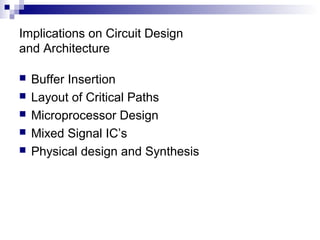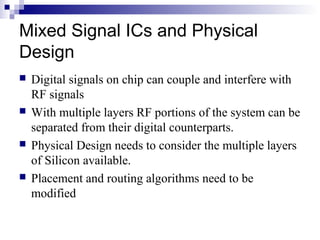3D IC TECHNOLOGY
- 1. 3D IC technology Pouya Dormiani Christopher Lucas
- 2. What is a 3D IC? “Stacked” 2D (Conventional) ICsCould be Heterogeneous…
- 3. Motivation Interconnect structures increasingly consume more of the power and delay budgets in modern design Plausible solution: increase the number of “nearest neighbors” seen by each transistor by using 3D IC design Smaller wire cross-sections, smaller wire pitch and longer lines to traverse larger chips increase RC delay. RC delay is increasingly becoming the dominant factor At 250 nm Cu was introduced alleviate the adverse effect of increasing interconnect delay. 130 nm technology node, substantial interconnect delays will result.
- 4. 3D Fabrication Technologies Many options available for realization of 3D circuits Choice of Fabrication depends on requirements of Circuit System Beam Recrystallization Processed Wafer Bonding Silicon Epitaxial Growth Solid Phase Crystallization Deposit polysillicon and fabricate TFTs -not practial for 3D circuits due to high temp of melting polysillicon -Suffers from Low carrier mobility -However high perfomance TFT’s have been fabricated using low temp processing which can be used to implement 3D circuits Bond two fully processed wafers together. -Similar Electrical Properties on all devices -Independent of temp. since all chips are fabricated then bonded -Good for applications where chips do independent processing -However Lack of Precision(alignemnt) restricts interchip communication to global metal lines. Epitaxially grow a single cystal Si -High temperatures cause siginificant cause significant degradation in quality of devices on lower layers -Process not yet manufacturable Low Temp alternative to SE. -Offers Flexibilty of creating multiple layers -Compatible with current processing environments -Useful for Stacked SRAM and EEPROM cells
- 5. Performance Characteristics Timing Energy With shorter interconnects in 3D ICs, both switching energy and cycle time are expected to be reduced
- 6. Timing In current technologies, timing is interconnect driven. Reducing interconnect length in designs can dramatically reduce RC delays and increase chip performance The graph below shows the results of a reduction in wire length due to 3D routing Discussed more in detail later in the slides
- 7. Energy performance Wire length reduction has an impact on the cycle time and the energy dissipation Energy dissipation decreases with the number of layers used in the design Following graphs are based on the 3D tool described later in the presentation
- 9. Design tools for 3D-IC design Demand for EDA tools As the technology matures, designers will want to exploit this design area Current tool-chains Mostly academic We will discuss a tool from MIT
- 10. 3D Standard Cell tool Design 3D Cell Placement Placement by min-cut partitioning 3D Global Routing Inter-wafer vias Circuit layout management MAGIC
- 11. 3D Standard Cell Placement Natural to think of a 3D integrated circuit as being partitioned into device layers or planes Min cut part-itioning along the 3rd dimension is same as minimizing vias
- 12. Total wire length vs. Vias Can trade off increased total wire length for fewer inter-plane vias by varying the point at which the design is partitioned into planes Plane assignment performed prior to detailed placement Yields smaller number of vias, but greater overall wire length
- 13. Total wire length vs. Vias (Cont) Plane assignment not made until detailed placement stage Yields smaller total wire length but greater number of vias
- 14. Intro to Global Routing Overview Global Routing involves generating a “loose” route for each net. Assigns a list of routing regions to a net without actually specifying the geometrical layout of the wires. Followed by detailed routing Finds the actual geometrical shape of the net within the assigned routing regions. Usually either sequential or hierarchical algorithms
- 15. Illustration of routing areas x z y x z y Detailed routing of net when routing areas are known
- 16. Hierarchical Global Routing Tool uses a hierarchical global routing algorithm Based on Integer programming and Steiner trees Integer programming approach still too slow for size of problem and complexity (NP-hard) Hierarchical routing methods break down the integer program into pieces small enough to be solved exactly
- 17. 2D Global Routing A 2D Hierarchical global router works by recursively bisecting the routing substrate. Wires within a Region are fully contained or terminate at a pin on the region boundry. At each partitioning step the pins on the side of the routing region is allocated to one of the two subregions. Wires Connect cells on both sides of the partition line. These are cut by the partition and for each a pin is inserted into the side of the partition Once complete, the results can be fed to a detailed router or switch box router (A switchbox is a rectangular area bounded on all sides by blocks)
- 19. Extending to 3D Routing in 3D consists of routing a set of aligned congruent routing regions on adjacent wafers. Wires can enter from any of the sides of the routing region in addition to its top and bottom 3D router must consider routing on each of the layers in addition to the placement of the inter-waver vias Basis idea is: You connect a inter-waver via to the port you are trying to connect to, and route the wire to that via on the 2D plane. All we need now is enough area in the 2D routing space to route to the appropriate via
- 20. 3D Routing Results Percentage Of 2D Total wire Length Minimizing for Wire Length: 2 Layers ~ 28% 5 Layers ~ 51 % Minimizing for via count: 2 Layers ~ 7% 5 Layers ~ 17%
- 21. 3D-MAGIC MAGIC is an open source layout editor developed at UC Berkeley 3D-MAGIC is an extension to MAGIC by providing support for Multi-layer IC design What’s different New Command :bond Bonds existing 2D ICs and places inter-layer Vias in the design file Once Two layers are bonded they are treated as one entity
- 22. Concerns in 3D circuit Thermal Issues in 3D-circuits EMI Reliability Issues
- 23. Thermal Issues in 3D Circuits Thermal Effects dramatically impact interconnect and device reliability in 2D circuits Due to reduction in chip size of a 3D implementation, 3D circuits exhibit a sharp increase in power density Analysis of Thermal problems in 3D is necessary to evaluate thermal robustness of different 3D technology and design options.
- 24. Heat Flow in 2D Heat generated arises due to switching In 2D circuits we have only one layer of Si to consider.
- 25. Heat Flow in 3D With multi-layer circuits , the upper layers will also generate a significant fraction of the heat. Heat increases linearly with level increase
- 26. Heat Dissipation All active layers will be insulated from each other by layers of dielectrics With much lower thermal conductivity than Si Therefore heat dissipation in 3D circuits can accelerate many failure mechanisms.
- 27. Heat Dissipation in Wafer Bonding versus Epitaxial Growth Wafer Bonding(b) 2X Area for heat dissipation Epitaxial Growth(a)
- 28. Heat Dissipation in Wafer Bonding versus Epitaxial Growth Design 1 Equal Chip Area Design 2 Equal metal wire pitch
- 29. High epitaxial temperature Temperatures actually higher for Epitaxial second layers Since the temperature of the second active layer T2 will Be higher than T1 since T1 is closer to the substrate and T2 is stuck between insulators
- 30. EMI in 3D ICs Interconnect Coupling Capacitance and cross talk Coupling between the top layer metal of the first active layer and the device on the second active layer devices is expected
- 31. EMI Interconnect Inductance Effects Shorter wire lengths help reduce the inductance Presence of second substrate close to global wires might help lower inductance by providing shorter return paths
- 32. Reliability Issues? Electro thermal and Thermo-mechanical effects between various active layers can influence electro- migration and chip performance Die yield issues may arise due to mismatches between die yields of different layers, which affect net yield of 3D chips.
- 33. Implications on Circuit Design and Architecture Buffer Insertion Layout of Critical Paths Microprocessor Design Mixed Signal IC’s Physical design and Synthesis
- 34. Buffer Insertion Use of buffers in 3D circuits to break up long interconnects At top layers inverter sizes 450 times min inverter size for the relevant technology These top layer buffers require large routing area and can reach up to 10,000 for high performance designs in 100nm technology With 3D technology repeaters can be placed on the second layer and reduce area for the first layer. Buffer Insertion
- 35. Layout of Critical Paths and Microprocessor Design Once again interconnect delay dominates in 2D design. Logic blocks on the critical path need to communicate with each other but due to placement and desig constraints are placed far away from each other. With a second layer of Si these devices can be placed on different layes of Si and thus closer to each other using(VILICs) In Microprocessor design most critical paths involve on chip caches on the critical path. Computational modules which access the cache are distributed all over the chip while the cache is in the corner. Cache can be placed on a second layer and connected to these modules using (VILICs)
- 36. Mixed Signal ICs and Physical Design Digital signals on chip can couple and interfere with RF signals With multiple layers RF portions of the system can be separated from their digital counterparts. Physical Design needs to consider the multiple layers of Silicon available. Placement and routing algorithms need to be modified
- 37. Conclusion 3D IC design is a relief to interconnect driven IC design. Still many manufacturing and technological difficulties Needs strong EDA applications for automated design





































